Shame! We Are Turning Our Rivers Into Sewers
Countercurrents.org
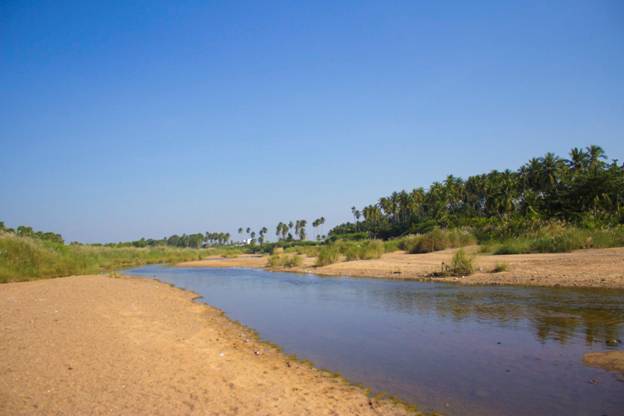
The Vaigai river at it's source. Plenty of sand with fairly clean water and out of the city limits.
Pic credit: Francis Harry Roy S
The fronds of grass waved gently in the breeze along the banks of the river Vaigai in Madurai. And almost 80 of us scrunched on the sands, down the almost dry river bed to listen to the DHAN Foundation tell us, about their inspirational work with Madurai's rivers. This was during the three day National Training Programme Climate Change News Coverage for Aspiring and Young Vernacular media persons in Madurai. Nothing like a field visit to see the crisis situation in the Vaigai and Kirudhumal river beds, in Madurai. After all the Vaigai river is considered to be the lifeline of Madurai and the importance of protecting and preserving and reversing the damage done, cannot be stressed enough. Unfortunately this was the idyllic and clean area of the river. We were in for a rude shock as the field visit wore on.
Like anywhere in India, Madurai district is dotted with hundreds of small and large water tanks that are networked with its main river Vaigai and minor river Kruthumal with the help of many distributor channels. However the wisdom of the city forefathers, has been lost in the greed of a growing population and urbanization. Valuable water collection tank beds have been built upon and the river itself is used like a sewer and so, the city now struggles for a decent supply of fresh water.
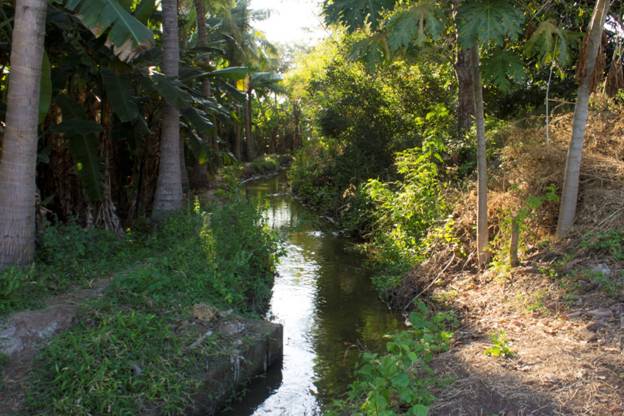
Pic credit: Francis Harry Roy S
The source which is kept clean
According to a paper entitled --Future Proofing Indian Cities: Towards an approach to spatial and social analysis for sustainable development of Madurai by Jayaraj Sundaresan. Development Planning Unit, University College London J. Kanagavalli. DHAN Foundation, Madurai their documentation has revealed the significant role of Kruthumal River in the historic, cultural, ecological and economic growth of Madurai. Centuries ago, Madurai city developed as a small urban settlement on the banks between the rivers Kruthumal6 and Vaigai. Appearing in epics and sacred texts such as Srimad Bhagavatham and Narayaneeyam, Kruthumal has significant presence in the written history of Madurai. It was also known as Narayana Cauvery. It supplied water to the Ahazhi (moat) around the Tirumalai Nayakkar palace in Madurai.
The origin of the river was in the Nagamalai hills, west of Madurai city. Apparently there are five original natural springs, nine in the foothills of Nagamalai all of which at some point feed into the Kruthumal River.

Map above-Various large water Tanks existing (blue) and reclaimed (red) in Madurai Urban region. Source: (Sivakumar and Kanagavalli, 2007)
During 70's the Kruthumall flowed with strength all through the year. Over the period, many changes to the source, the catchment and the inlet-outlet resulted in the depletion of the original source of water. Well irrigation that boomed in the command area of the tanks resulted in poor cooperation among the farmers. The river bed has been encroached and its width reduced drastically.
With urbanisation and a growing population, agricultural lands were converted for residential use. Land use changes at the original catchment, the redirection of water to Nilayur channel and the changed geomorphology of the Vaigai River contributed to the drying up of the Kruthumal river channel.
Over the years indiscriminate sand mining, lowered the Vaigai riverbed, while the bed level of the off-take channels from Vaigai1 carrying water to Kruthumal remained at the higher elevation. For example, many parts near the Thuvariman tank, the Vaigai river bed is almost three meters below the original river bed level. This resulted in dysfunction of the supply channels, even when there is a normal flow.
The paper goes on to explain that Madakulam Keel Madurai refers to a village under the Madakulam tank, which expanded into an urban area after 1950's. Many rural communities migrated to the city and settled on either side of the river. A combination of inefficient Planning to meet the demand for space along with the poor infrastructure facilities of the newly developed area resulted in the Kruthumal River channel being used for sewage and waste disposal.
DHAN then undertook a basic documentation of the river channel which revealed how the shift in the use of the adjoining land destroyed the river corridor. For example from Thuvariman tank to Achampathu, the river is relatively clean. The first ingress of wastewater occurs between Achampathu and Virattupathu. This grows worse as the river moves into the city.
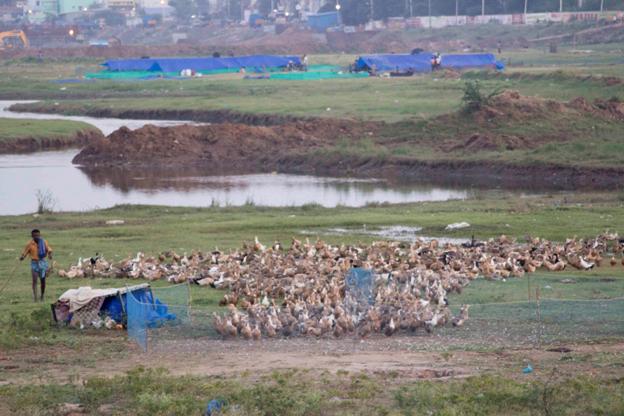
Ducks being nutured on the dry Vaigai river bed once it reaches the city.
Pic credit: Francis Harry Roy S
In the central parts of the city, for example, near the Periyar bus stand, the river becomes a swamp of solid waste, heavy metals, sewage, sullage, and other kinds of waste from different parts of the city. Not only do individual households, public and semi-public institutions and industries discharge their waste water onto the channel but the municipal corporation's centralized sewage system as well as the septic tank cleaning companies also utilizes the channel to dispose of waste in large quantities. In many places like Achampathu, Virattipathu, Dhidir Nagar . If the government adopts this method of waste disposal local residents too do the same. Solid waste is disposed all along the river length including animal waste from meat and fish selling units and corpses of dead animals. Moreover, the waste water is blocked using various means to pump up to grow greens and vegetables. Due to insufficient capacity of the drainage and sewerage network and the waste disposal system, a large number of land uses along the river corridor use the channel to get rid of their waste; these include cattle farms, rice mills, garage and metal works and so on. This highly poisonous wastewater is finally drained on to Samanatham tank again in the south East of the city, before it moves on.
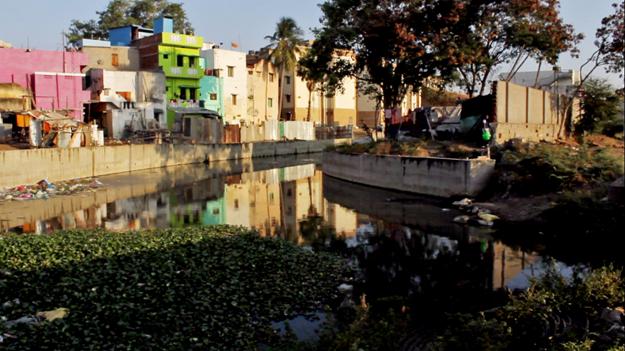
The shockingly filthy river once in the city. which has turned into a sewer
Pic credit: Francis Harry Roy S
We stood on the concrete banks of the same 'river ' in the city holding our noses. The stench was unbearable. the women from the surrounding slums came to complain, the living conditions of the people around were sub-human. They surely realised that the crisis they were facing was due to a combination of governmental apathy and a complete lack of civic sense.
At many places the channel is silted and infested with weeds resulting in the blockage of flow and stagnation of polluted water. Concretization of the channel edge as well as the riverbed (funded by JnNURM project) not only reduced the channel width (abrupt reduction of channel, it varies between 12 m to 3m) but it also leads to flooding in many places even during a normal rainfall, This pollutes the ground water which is being pumped out to use in households.
According to DHAN, ownership and management of the system tanks and water bodies and river channels in Madurai used to be the responsibility of the Public Works Department. Being a department that manages such networked infrastructure across the region, their management style considered the corridor in its entirety rather than as fragmented pieces located in different parts of the city. A couple of decades ago, the maintenance responsibility of those parts of the water network that ceased to have an ayacut within the city, were transferred to the Municipal Corporation. Being an organization that works mostly with ward boundaries and city corporation boundaries and over strained on its services infrastructure and management capabilities, the river corridor ( and other such water channels) became the default location that the corporation depended on to solve the challenges that arose out of the insufficient waste management capacity.
In short a complex confluence of situations, actors, institutional governance setup and so on resulted in the transformation of Kruthumal River that used to be one of the most significant ecological, cultural and heritage water systems that contributed to a range of eco system services like micro climate stabilization, ground water recharge, purification of the soil and so on in Madurai to become a sewage channel that just carries out the dirt of Madurai's urban life.
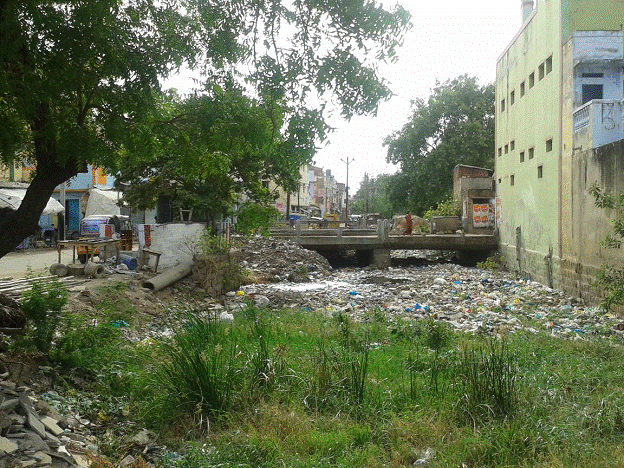
Picture credit: DHAN
In its present state, the river corridor actively contributes to poor living condition in the city - polluted environment, unhealthy agriculture, water borne diseases, flooding, water stagnation, and poses very high challenges to any remediation efforts. Within the city, the river passes through 16 wards; many middle class locations and 18 informal settlements. While the middle class localities suffer from the foul smell, mosquitoes and threat of communicable diseases, the informal settlement dwellers suffer the most due to their active dependency and proximity to this water body. Even though the whole city contributes to the pollution, significant impacts are felt by the slums adjacent to the channel. Further, the farmers downstream who depend on the water from the river are affected severely.
Due to the unplanned development upstream, the river became a default carrier of sewage and sullage from the households. Since there is no flow in the river, banks were encroached by buildings and the wastewater from most of that drains on to the river. The many tanks to which this river carried water dried and the means of ground water recharge disappeared. Further, when the riverbanks and tanks are encroached, the tanks do not anymore function as flood moderators; the area around these water bodies gets frequently flooded.
Though the city gets 928 mm of annual rainfall, the groundwater table fluctuates constantly. Moreover the quality of ground water is poor and not potable. As a result the city's water needs are met from the sources based on Vaigai River and reservoirs located 70 km from the city. Individual households depend on bore wells and this has resulted in a rapidly depleting ground water table. According to the paper Madurai has exhausted its shallow aquifers. Plus the number and the depth of the bore wells are increasing every year, posing serious questions on water management.
As we stood covering our noses near the river alongside a slum the women of the area told us about the swarms of mosquitos that would descend every night on them. These mosquitos gave their children and them a range of communicable diseases. It was reported by the women that the expenditure on health, mosquito repellents and electricity (for Fan and Air Conditioners) have increased drastically. The polluted water contributes to spread of water borne diseases such as frequent fever, chronic cough and skin infections.
The paper gave various methods to look after the river:
1) Protection of source: Kruthumal origin at Thuvariman Lake should be protected to revive the origin and to ensure water flow in the channel. Madakulam and Thuvariman tanks and their catchments should be protected. And during the monsoon, the water should be diverted from Nilaiyur channel to enable a better flow in the Kruthumal. This say the scientists will not only clean the channel, but also will reduce encroachments and improve ground water recharge.
2) There should be regulation of sand mining in place by the government: Rivers, and channels running close to city are found to be mostly prone to extensive sand mining damaging and the ecology of these water bodies. Sand mining should be strictly regulated.
3) Effective storm water management: All the storm water drains should be properly connected to the Kruthumal to ensure the inflow of the monsoon rainwater. Further, sewage and sullage and other polluting waste water outlets into the storm water drains should be sealed.
4) To see that all the above works effectively, the government should build efficient and complete sewerage networks: Effective systems are to be put in place for underground drainage and solid waste management that cater to the future population growth. A large number of properties in the city, both formal and informal are not connected to the existing sewage and drainage network. Such properties continue to discharge into the city's channels in addition to the large scale pumping by concerned authorities and commercial sewage disposal companies.
5) The scientists also feel that the city fathers should build social capital: Citizens should recognize the importance of the river. Therefore appropriate platforms for campaign advocacy and multi-stakeholder involvement should be developed. The Government should take proper steps for building of basic toilet facilities for slum dwellers in the area.
6) Enforcement of Law: According to DHAN, though there are laws to evict the encroachers of waterways, interference of political figures makes it difficult to enforce such laws. Therefore people should be mobilized to protect the water bodies so that law enforcement could be more effective. Special laws should be enacted within the local body and state government to protect the waterways and water bodies. Eviction of encroachment, construction of access roads on either side of Kruthumal, tree planting and so on could open the corridor as a valuable public space. This will ensure that people will have a healthy relationship with the river corridor and the river does not remain in the backyard of the public eye.
Looking at the condition of the water body one feels it is hopeless, but there is hope if together with the government, something is done to control the destruction of the river, by law. And with organizations like DHAN Madurai can hope for a clean Vaigai in the future.
Marianne Furtado de Nazareth

